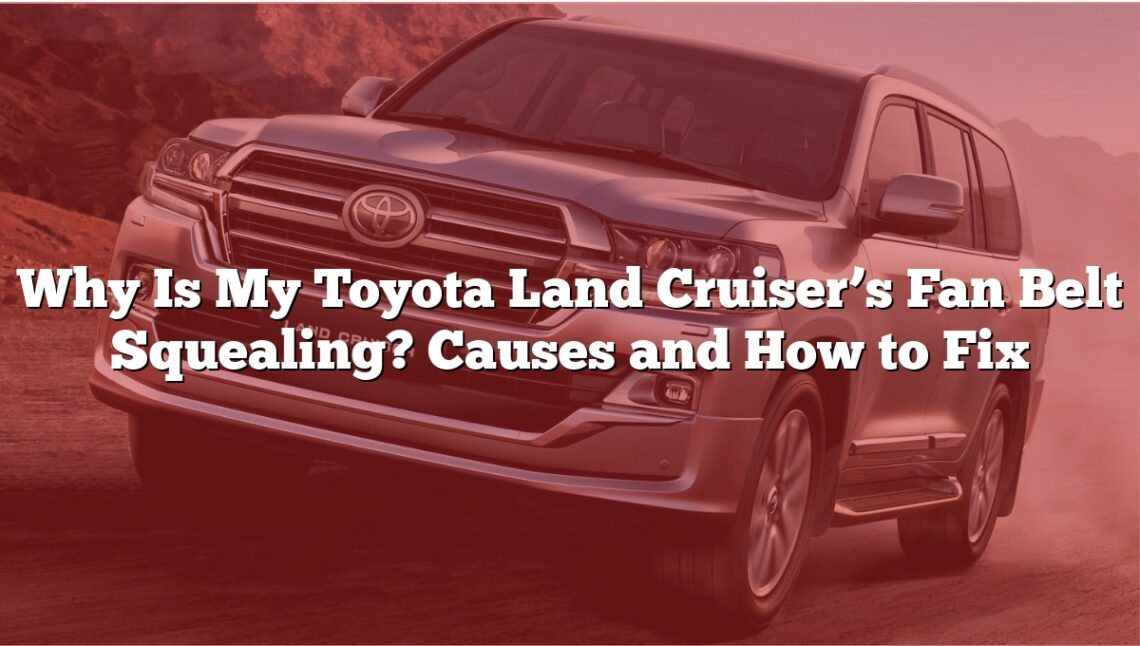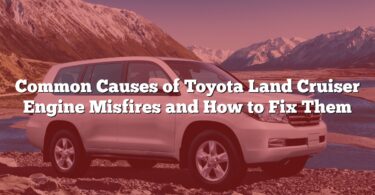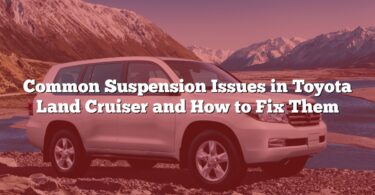A squealing fan belt can be a frustrating and embarrassing problem for any Toyota Land Cruiser owner. Whether it’s a high-pitched noise when you start the engine or a persistent squeak while driving, it’s often a sign of underlying issues that shouldn’t be ignored. In this guide, we’ll explore the most common causes of fan belt squealing and provide clear, practical solutions to help you fix the problem and keep your vehicle running smoothly.
Comprehensive Guide: Problems and Solutions for Toyota Land Cruiser’s Fan Belt Squealing
| N° | Problem / Cause | Solution |
|---|---|---|
| 1 | Worn-out fan belt | Replace the fan belt with a new one. |
| 2 | Loose fan belt tension | Adjust the tensioner to achieve proper tension. |
| 3 | Over-tightened fan belt | Loosen the belt tension to manufacturer specifications. |
| 4 | Misaligned pulleys | Realign the pulleys for proper belt tracking. |
| 5 | Worn pulley bearings | Replace the damaged bearings. |
| 6 | Contaminated belt (oil, grease, coolant, or water) | Clean the belt and remove the source of contamination. |
| 7 | Cracked or frayed belt | Replace the belt immediately. |
| 8 | Dry or unlubricated pulleys | Apply appropriate lubrication to pulleys. |
| 9 | Incorrect belt size or type | Install the correct belt size and type specified for the vehicle. |
| 10 | Excessive belt wear due to age | Replace the aged belt with a new one. |
| 11 | Faulty belt tensioner | Replace the faulty tensioner. |
| 12 | Damaged or defective alternator | Repair or replace the alternator. |
| 13 | Faulty water pump | Replace the water pump. |
| 14 | Malfunctioning air conditioning compressor | Repair or replace the air conditioning compressor. |
| 15 | Idler pulley failure | Replace the idler pulley. |
| 16 | Excessive engine vibration | Check and repair engine mounts or balance the engine. |
| 17 | Belt slipping due to high load | Reduce load on accessories or check for proper belt tension. |
| 18 | Cold weather (stiffened belt material) | Warm up the engine or replace with a weather-resistant belt. |
| 19 | Poor-quality replacement belt | Replace with a high-quality OEM belt. |
| 20 | Belt improperly installed | Reinstall the belt correctly, following the manufacturer’s guide. |
| 21 | Corroded or dirty pulley grooves | Clean the pulley grooves thoroughly. |
| 22 | Overloading accessories driven by the belt | Reduce accessory usage or upgrade the belt system if necessary. |
| 23 | Inconsistent tension adjustment system | Repair or replace the tension adjustment mechanism. |
| 24 | Weather conditions affecting belt stiffness | Use a weather-resistant belt or store the vehicle in a sheltered area. |
| 25 | Basic wear and tear over time | Replace the belt regularly as part of routine maintenance. |
| 26 | Improper re-tensioning after installation | Retighten the belt after initial installation and use. |
| 27 | Glazed or brittle belt surface | Replace the belt with a new one. |
| 28 | Misaligned tensioner or pulley | Realign or replace the tensioner or pulley as needed. |
| 29 | Deposits or buildup on pulleys | Clean the pulley surfaces to remove deposits or buildup. |
| 30 | External debris causing damage | Remove debris and inspect the belt for any damage. |
Detailed Guide :Problems and Solutions for Toyota Land Cruiser’s Fan Belt Squealing
1. Worn-out Fan Belt
Over time, fan belts wear out due to regular use. The material weakens, leading to cracks, fraying, or loss of elasticity. This results in a squealing noise as the belt struggles to maintain grip on the pulleys.
Solution:
Replace the fan belt.
Steps:
- Turn off the engine and allow it to cool completely.
- Locate the belt and note its routing. Take a photo for reference.
- Loosen the tensioner to remove the old belt.
- Install the new belt following the correct routing.
- Adjust the tension to manufacturer specifications.
2. Loose Fan Belt Tension
Loose tension occurs when the belt slackens over time or if the tensioner fails. This causes the belt to slip on the pulleys, generating noise.
Solution:
Adjust the tensioner to the correct specification.
Steps:
- Locate the tensioner and loosen its bolt.
- Use a pry bar or adjuster tool to increase belt tension.
- Tighten the bolt and test for proper tension (1/2 inch deflection is typical).
3. Over-tightened Fan Belt
Excessive tension stresses the belt, leading to squealing and potential damage to the belt or pulleys.
Solution:
Loosen the belt tension to the correct level.
Steps:
- Loosen the tensioner or adjuster bolts.
- Reduce the tension to the manufacturer-recommended level.
- Secure the bolts and verify the adjustment.
4. Misaligned Pulleys
If the pulleys are misaligned, the belt cannot maintain proper contact, causing slipping and noise.
Solution:
Realign the pulleys.
Steps:
- Inspect each pulley for alignment using a straight edge.
- Adjust mounting brackets or replace bent components.
- Ensure proper alignment before re-installing the belt.
5. Worn Pulley Bearings
Worn or damaged pulley bearings create friction, leading to belt squealing.
Solution:
Replace the affected bearings.
Steps:
- Identify the noisy pulley by spinning each manually.
- Remove the pulley and replace the bearing with a compatible one.
- Reinstall the pulley and belt.
6. Contaminated Belt (Oil, Grease, Coolant, or Water)
Fluids on the belt reduce its grip, causing squealing.
Solution:
Clean the belt and remove the source of contamination.
Steps:
- Wipe the belt and pulleys with a clean, dry cloth.
- Use a degreaser to remove stubborn contamination.
- Address any fluid leaks in the engine.
7. Cracked or Frayed Belt
Cracks or fraying weaken the belt and disrupt its function.
Solution:
Replace the damaged belt.
Follow the steps under 1. Worn-out Fan Belt.
8. Dry or Unlubricated Pulleys
Dry pulleys increase friction, making the belt squeal.
Solution:
Apply appropriate lubrication.
Steps:
- Identify the affected pulleys.
- Use manufacturer-recommended lubricants on the bearings.
- Avoid over-lubricating to prevent contamination of the belt.
9. Incorrect Belt Size or Type
Using the wrong belt results in improper tension or fit.
Solution:
Install the correct belt specified for your vehicle.
Consult your owner’s manual or parts guide for the correct part number.
10. Excessive Belt Wear Due to Age
Old belts lose elasticity and may develop glazing, causing noise.
Solution:
Replace the belt with a new one.
Follow the steps under 1. Worn-out Fan Belt.
11. Faulty Belt Tensioner
A malfunctioning tensioner cannot maintain the required tension.
Solution:
Replace the tensioner.
Steps:
- Remove the old tensioner by loosening its mounting bolts.
- Install a new tensioner.
- Adjust the belt tension properly.
12. Damaged or Defective Alternator
A failing alternator can create abnormal resistance, causing belt noise.
Solution:
Repair or replace the alternator.
Consult a professional mechanic if alternator replacement is needed.
13. Faulty Water Pump
A malfunctioning water pump can disrupt belt function.
Solution:
Replace the water pump.
Consult your vehicle’s repair guide for step-by-step instructions.
14. Malfunctioning Air Conditioning Compressor
Compressor issues increase belt load, causing squealing.
Solution:
Repair or replace the compressor.
15. Idler Pulley Failure
Idler pulleys guide the belt. Failure causes misalignment and noise.
Solution:
Replace the idler pulley.
16. Excessive Engine Vibration
Vibration disrupts belt alignment.
Solution:
Inspect engine mounts and balance the engine as needed.
17. Belt Slipping Due to High Load
Excessive load on the belt from accessories like the alternator or air conditioning compressor causes slipping.
Solution:
Reduce the load or check for proper tension.
Steps:
- Turn off high-load accessories such as the AC temporarily to identify if the load is the issue.
- Adjust the belt tension to prevent slipping.
- If the issue persists, inspect the accessories for malfunctions and repair or replace them.
18. Cold Weather (Stiffened Belt Material)
In cold weather, the belt material becomes less flexible, causing squealing.
Solution:
Warm up the engine or replace the belt with a weather-resistant one.
Steps:
- Allow the engine to run for a few minutes to warm up the belt before driving.
- If the noise continues, replace the belt with one designed for extreme weather conditions.
19. Poor-Quality Replacement Belt
Inferior-quality belts wear out quickly and lose their grip.
Solution:
Replace the belt with a high-quality OEM belt.
Ensure the replacement belt meets the manufacturer’s specifications for material and design.
20. Belt Improperly Installed
Improper installation leads to misalignment or incorrect tension.
Solution:
Reinstall the belt correctly.
Steps:
- Remove the belt.
- Check the routing diagram in the vehicle manual.
- Install the belt following the diagram.
- Adjust the tension correctly.
21. Corroded or Dirty Pulley Grooves
Dirt or corrosion in the pulley grooves reduces grip, causing the belt to slip.
Solution:
Clean the pulley grooves thoroughly.
Steps:
- Remove the belt.
- Use a wire brush or cleaner to remove debris and corrosion from the pulleys.
- Reinstall the belt.
22. Overloading Accessories Driven by the Belt
Excessive accessory use increases strain on the belt.
Solution:
Reduce accessory usage or upgrade the belt system.
Steps:
- Limit simultaneous use of high-power accessories like AC and headlights.
- Consider installing a belt system designed to handle higher loads if necessary.
23. Inconsistent Tension Adjustment System
A faulty tensioner mechanism can lead to inconsistent belt tension.
Solution:
Repair or replace the tension adjustment mechanism.
Steps:
- Inspect the tension adjustment system for damage.
- Replace or repair defective components.
- Test the new system for consistent tension.
24. Weather Conditions Affecting Belt Stiffness
Extreme weather conditions, such as heat or cold, can affect belt flexibility.
Solution:
Use a weather-resistant belt or store the vehicle in a sheltered area.
Steps:
- Replace the belt with one suitable for your climate.
- Park the vehicle in a garage or covered space to minimize exposure to extreme weather.
25. Basic Wear and Tear Over Time
Normal use over time causes the belt to lose elasticity and wear out.
Solution:
Replace the belt regularly as part of routine maintenance.
Steps:
- Schedule belt inspections during regular vehicle servicing.
- Replace the belt according to the manufacturer’s maintenance schedule.
26. Improper Re-Tensioning After Installation
Failure to re-tension the belt after installation leads to premature slipping or noise.
Solution:
Re-tension the belt after installation.
Steps:
- Install the belt and set the initial tension.
- Run the engine for a few minutes to allow the belt to settle.
- Recheck and adjust the tension as needed.
27. Glazed or Brittle Belt Surface
A glazed or brittle surface reduces the belt’s grip.
Solution:
Replace the belt with a new one.
Follow the steps outlined in 1. Worn-out Fan Belt.
28. Misaligned Tensioner or Pulley
A misaligned tensioner or pulley disrupts the belt’s path, causing slipping.
Solution:
Realign or replace the tensioner or pulley.
Steps:
- Inspect the tensioner and pulleys for alignment.
- Adjust or replace the misaligned components.
- Reinstall the belt and test for proper operation.
29. Deposits or Buildup on Pulleys
Debris or buildup on pulleys disrupts belt contact.
Solution:
Clean the pulley surfaces.
Steps:
- Remove the belt.
- Clean the pulley surfaces using a wire brush or cleaner.
- Reinstall the belt.
30. External Debris Causing Damage
Debris in the engine bay can damage the belt.
Solution:
Remove debris and inspect the belt for damage.
Steps:
- Clean the engine bay thoroughly.
- Inspect the belt for cracks or tears caused by debris.
- Replace the belt if damaged.
Preventing Future Issues
To ensure your Toyota Land Cruiser’s fan belt remains in good condition and prevents future squealing, follow these preventive maintenance steps:
- Regular Inspections
- Check the fan belt every 10,000 miles or as recommended by your vehicle’s manufacturer.
- Look for signs of wear, such as cracks, fraying, or glazing on the belt surface.
- Maintain Proper Tension
- Inspect the belt tension regularly and adjust it if necessary.
- Use a tension gauge to measure deflection and ensure it meets the manufacturer’s specifications.
- Clean Pulley Grooves
- Remove dirt, debris, and corrosion from pulley grooves during routine maintenance.
- Use a wire brush or degreaser to keep the pulleys clean and free from buildup.
- Avoid Contamination
- Inspect the engine for oil or coolant leaks and fix them immediately to prevent contamination of the belt.
- Keep the engine bay clean and dry to minimize the risk of external debris affecting the belt.
- Replace Belts on Schedule
- Replace the fan belt every 50,000 to 70,000 miles or as specified by your vehicle manual.
- Always opt for high-quality, OEM-recommended belts to ensure durability.
- Monitor Accessory Components
- Inspect the tensioner, idler pulleys, alternator, water pump, and AC compressor for wear or damage.
- Replace any failing components promptly to avoid unnecessary strain on the belt.
- Protect Against Weather Extremes
- In colder climates, start the engine and let it warm up before driving to prevent belt stiffness.
- Use weather-resistant belts if you frequently drive in extreme temperatures.
- Avoid Overloading Accessories
- Limit simultaneous use of high-power accessories like air conditioning, headlights, and heated seats.
- Upgrade the belt system if you’ve added aftermarket accessories that increase load.
By following these steps, you can prolong the life of your fan belt, minimize the risk of squealing, and ensure smooth operation of your vehicle. Regular maintenance is key to avoiding unexpected breakdowns and costly repairs.







